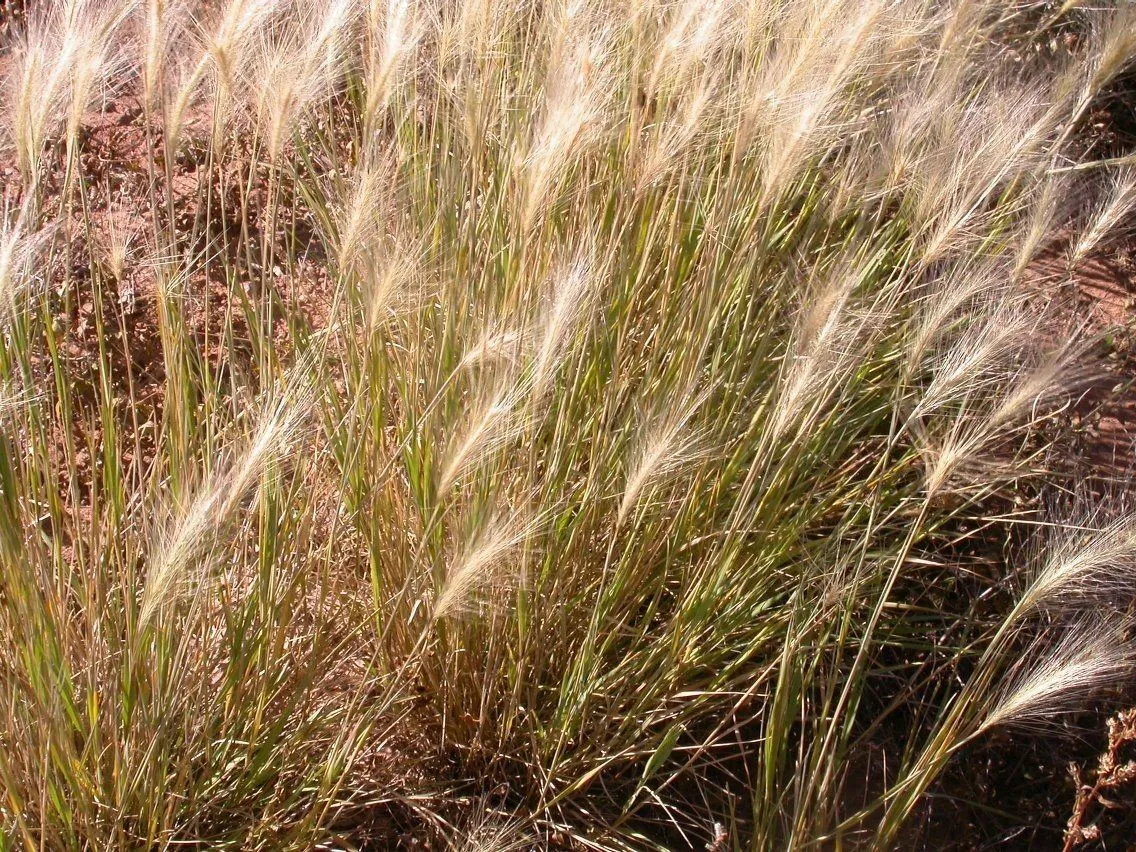
Author: L.
Bibliography: Sp. Pl.: 85 (1753)
Year: 1753
Status: accepted
Rank: species
Genus: Hordeum
Vegetable: False
Observations: Siberia to Caucasus and NE. China, N. America
Foxtail barley, known scientifically as Hordeum jubatum, is a remarkable and widespread species of grass that belongs to the Poaceae family. This plant was first described in 1753 by the renowned botanist Carl Linnaeus in his seminal work “Species Plantarum”.
Foxtail barley is native to a broad geographical range that spans from Siberia to the Caucasus and Northeast China, demonstrating remarkable adaptability across diverse climates and terrains. It is also widely distributed across North America, where it has adapted well to the environment.
This perennial grass is easily recognizable by its dense, bushy inflorescences, and its distinctive seed heads that resemble the soft, bushy tail of a fox — hence the common name. The seed heads are prominently adorned with fine awns that catch the light, giving the plant a luminous, almost ethereal quality when swaying in the wind.
Although beautiful, foxtail barley can be a problematic species in agricultural settings. The sharp awns can cause discomfort or harm to grazing animals by becoming lodged in their mouths and other body parts. Consequently, farmers and land managers need to monitor and manage this plant to prevent it from becoming overly dominant in grazing areas.
Despite its challenges, foxtail barley holds ecological value. It can thrive in a variety of soil types and conditions, often establishing itself in disturbed soils where other vegetation might struggle. This resilience makes it useful for soil stabilization and erosion control, contributing to the long-term health of the ecosystem.
In summary, Hordeum jubatum is a striking, adaptable grass species with both beneficial and detrimental qualities. Its widespread distribution from Siberia to North America showcases its ability to thrive in diverse environments, while its distinctive appearance makes it easily identifiable in the wild. As such, it remains an important subject of study for both its ecological impact and its role in the natural beauty of the landscapes it inhabits.
Dan: egernhale-byg
Eng: foxtail barley, squirreltail, foxtail, squirrel-tail barley, squirreltail barley, squirreltail grass, wild barley
Pol: jęczmień grzywiasty
Lit: kar
Nld: kwispelgerst
Deu: mähnen-gerste, mähnengerste
Fra: orge barbue, orge à crinière, orge queue-d’écureuil, finette, orge agréable, petit minou, queue d’écureuil
Hun: díszárpa
Swe: ekorrkorn, partaohra
Ces: je
Lav: krēpju miezis
Est: lakkoder
Fin: partaohra
Nob: silkebygg
Nno: silkebygg
Sme: oarribivgi
Por: cevada-de-jardim, cevada-rabo-de-raposa
Cym: haidd cribog, heiddwellt cribog
En: Foxtail barley, FOX-TAIL BARLEY, Bobtail barley, Squirreltail, Foxtail, Squirrel-tail barley, Squirreltail barley, Squirreltail grass, Wild barley
Cs: Je
Da: Egernhale-byg
Nl: Kwispelgerst
Et: Lakkoder
Fi: Partaohra
Fr: Orge à crinière, Orge barbue, Orge queue-d’écureuil, Finette, Orge agréable, Petit minou, Queue d’écureuil
De: Mähnengerste, Mähnen-Gerste, Mähnen Gerste
Hu: Díszárpa
It: Orzo crinito
Lv: Krēpju miezis
Lt: Kar
Se: Oarribivgi
Nb: Silkebygg
Nn: Silkebygg
Pl: Jęczmień grzywiasty
Pt: Cevada-de-jardim, Cevada-rabo-de-raposa
Pt-br: Cevada-de-jardim, Cevada-rabo-de-raposa
Sv: Ekorrkorn, Partaohra
Cy: Haidd Cribog, Heiddwellt Cribog
Taken Jul 15, 2019 by Jon Jon (cc-by-sa)
Taken Jul 15, 2019 by Jon Jon (cc-by-sa)
Taken Aug 13, 2020 by morash (cc-by-sa)
Taken Jul 20, 2021 by Cindy Cameron (cc-by-sa)
Taken Jul 27, 2021 by Deborah Welch (cc-by-sa)
Taken Jul 2, 2021 by Clint Grierson (cc-by-sa)
Taken Jul 5, 2022 by alina (cc-by-sa)
Taken Jun 7, 2022 by Melina CORRE (cc-by-sa)
Taken Jul 24, 2009 by EOL − Encyclopedia of Life (cc-by-nc-sa)
Taken Apr 15, 2021 by Guy MOLL (cc-by-sa)
Taken May 16, 2021 by Benoit Rostagni (cc-by-sa)
Taken Jul 1, 2019 by Hosseini Amjad (cc-by-sa)
Taken Jul 17, 2021 by Vincent HERVÉ (cc-by-sa)
Taken Jun 20, 2020 by Mikhail (cc-by-sa)
Taken Oct 3, 2020 by antoine leblanc-boily (cc-by-sa)
Taken Jan 1, 1900 by EOL − Gerrit Davidse (cc-by-nc-sa)
Taken Jun 30, 2015 by EOL − Mike Leveille (cc-by-nc)
Taken Aug 19, 2015 by EOL − Mike Leveille (cc-by-nc)
Taken Sep 6, 2015 by EOL − Mike Leveille (cc-by-nc)
Taken Jun 10, 2015 by EOL − klmaher (cc-by-nc)
Taken May 15, 2018 by Photoflora – Jean-Luc TASSET (©)
Taken Jan 1, 1900 by EOL − Gerrit Davidse (cc-by-nc-sa)
Taken Aug 10, 2009 by EOL − Zoya Akulova (cc-by-nc)
Taken Jan 1, 1900 by EOL − Gerrit Davidse (cc-by-nc-sa)
© copyright of the Board of Trustees of the Royal Botanic Gardens, Kew.
© copyright of the Board of Trustees of the Royal Botanic Gardens, Kew.
© copyright of the Board of Trustees of the Royal Botanic Gardens, Kew.
Growth habit: Graminoid
Ph maximum: 7.5
Ph minimum: 7.0
Light: 9
Atmospheric humidity: 2
Soil nutriments: 6
Soil salinity: 2
Family: Myrtaceae Author: (F.Muell.) K.D.Hill & L.A.S.Johnson Bibliography: Telopea 6: 402 (1995) Year: 1995 Status:…
Family: Rubiaceae Author: Pierre ex A.Froehner Bibliography: Notizbl. Bot. Gart. Berlin-Dahlem 1: 237 (1897) Year:…
Family: Sapindaceae Author: Koidz. Bibliography: J. Coll. Sci. Imp. Univ. Tokyo 32(1): 38 (1911) Year:…
Family: Asteraceae Author: A.Gray Bibliography: Pacif. Railr. Rep.: 107 (1857) Year: 1857 Status: accepted Rank:…
Family: Fabaceae Author: Medik. Bibliography: Vorles. Churpfälz. Phys.-Ökon. Ges. 2: 398 (1787) Year: 1787 Status:…
Family: Aspleniaceae Author: (Cav.) Alston Bibliography: Bull. Misc. Inform. Kew 1932: 309 (1932) Year: 1932…